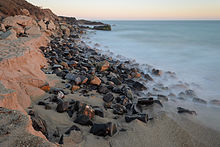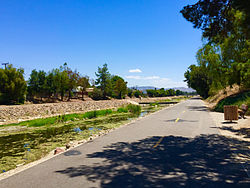Ventura County, California
[27] In October 1542, the expedition led by Juan Rodríguez Cabrillo anchored in an inlet near Point Mugu; its members were the first Europeans to arrive in the area that would become Ventura County.Gaspar de Portolà led a military expedition by land from San Diego to Monterey, passing through Ventura County in August of that year.A priest with the expedition, Father Juan Crespí, kept a journal of the trip and noted that the area was ideal for a mission to be established and it was a "good site to which nothing is lacking".The area proved to be a treasure trove for archaeologists who braved the lingering smell in the dirt to uncover artifacts that showed heavy utilization by mission inhabitants, Indians, early settlers and Spanish and Mexican soldiers.In January of that year, Captain John C. Frémont led the California Battalion into San Buenaventura to find that the Europeans had fled, leaving only Native Americans in the Mission.[47] This tunnel joined to the railroad spur coming the other direction from Montalvo through Camarillo, Moorpark and Simi Valley, making the contemporary main line used today.That community, now bearing the name of the factory shortened to the one word train stop Oxnard, has become the largest city in Ventura County.[48][49] Oil has been known in Ventura County since before the arrival of the Europeans, as the native Chumash people used tar from natural seeps as a sealant and waterproofing for baskets and canoes.[50][51] In the early hours of the morning of March 12–13, 1928, the St. Francis Dam collapsed, sending nearly 12,500 million U.S. gallons (47 gigaliters) of water rushing through the Santa Clarita Valley killing as many as 600 people,[52] destroying 1,240 homes and flooding 7,900 acres (32 km2) of land, devastating farm fields and orchards.Geographically East County is the end of the Santa Monica Mountains, in which the Conejo Valley is located, and where there is a considerable increase in elevation.Development in the East County and along the US 101 corridor is rare today, because most of these cities, such as Thousand Oaks and Simi Valley, are approaching build-out.[55] Because of this, its private low-key location, its country feel, and its proximity to Los Angeles, the Conejo Valley area has become a very attractive place to live.It burned approximately 281,893 acres (440 sq mi; 114,078 ha), becoming the largest wildfire in modern California history, before it was fully contained on January 12, 2018.[59][61][62] Southern California Edison paid the county over $11 million in claims related to damages and costs since its equipment was likely associated with one ignition point of the fire near Santa Paula.[68] The USDA Economic Research Service rated Ventura County the most desirable county to live in the 48 contiguous states, using six metrics of climate ("mild, sunny winters, temperate summers, low humidity"), topographic variation, and access to water, "that reflect environmental qualities most people prefer.[64] North of Highway 126, the county is mountainous and mostly uninhabited, and contains some of the most unspoiled, rugged and inaccessible wilderness remaining in southern California.The Santa Clara River drains an area of 1,605 square miles (4,160 km2) and flows from its headwaters in Los Angeles to where it empties into the Pacific.To the south, over the Camarillo- and Las Posas Hills, are Santa Rosa- and Tierra Rejada Valleys, which extend from Camarillo eastward for ten miles (16 km).For July, the average maximum temperature is between 70 °F and 80 °F on the Coastal Plain but exceeds 90 °F in the upper part of the Ventura- and Cuyama River Valleys.[97] The United States Office of Management and Budget has designated Ventura County as the Oxnard–Thousand Oaks–Ventura, CA Metropolitan Statistical Area.[99][100] In 2019, the county faced a weak economic outlook due to the declining housing affordability and lack of job growth.[114] Under the legalization of the sale and distribution of cannabis in California, Ventura County voters approved Measure O in 2020, which sets up taxes on marijuana cultivation, as well as limits on the amounts of growing.[130] Much of the county, including the cities of Thousand Oaks, Oxnard and Moorpark, lie within the 26th congressional district, which is represented by Democrat Julia Brownley.[132] For the previous twenty five years, most of Ventura County was represented by Elton Gallegly, a conservative Republican from Simi Valley, who retired in 2012.The incorporated cities of Ventura, Oxnard, Simi Valley, Port Hueneme, and Santa Paula have municipal police departments.Ventura County is home to several of the safest communities in the U.S., including Thousand Oaks, Simi Valley, Newbury Park, and Moorpark.The colleges and universities in Ventura County support libraries to meet the research needs of their students and faculty and, in some cases, the general public.[159][160] The 1938 film, The Adventures of Robin Hood, starring Errol Flynn, also had a major scene shot on location at "Sherwood Forest".The movie Back to the Future Part III filmed the scene where Marty returns to the year 1985 in the time-traveling DeLorean at the railroad crossing at S Ventura Rd & Shoreview Dr in Port Hueneme.The theater has hosted many internationally notable musician and bands such as Gregg Allman, John Prine, Glenn Frey, The Doors, Devo, Joe Walsh, King's X, Van Halen, X, Paramore, She Wants Revenge, Pennywise, Red Hot Chili Peppers, Snoop Dogg, Drakeo the Ruler, DJ Jazzy Jeff & The Fresh Prince, The Game, DJ Quik, Lamb of God, Social Distortion, Bad Religion, Thrice, Avenged Sevenfold, Fugazi, Incubus, Tom Petty, America, They Might Be Giants, and Modest Mouse, as well as local artists such as Army of Freshmen and Big Bad Voodoo Daddy.















CountyVentura City HallCamarilloRonald Reagan Presidential LibrarySimi ValleyPoint MuguCaliforniaRegionGreater Los AngelesCalifornia Central CoastNamed forMission San BuenaventuraSaint BonaventureCounty seatVenturaOxnardThousand OaksCouncil–CEOJeff GorellChief executive officerApril 1, 2020Time zoneUTC−8Pacific Time ZoneUTC−7Pacific Daylight TimeArea codes805/820818/747the southern partU.S. state2020 censusChannel IslandsAnacapa IslandChannel Islands National ParkSan Nicolas IslandBurro Flats Painted CaveChumash peopleSanta BarbaraSan Luis Obispohunter-gatherersMojaveYokutsTongvaChumashVentura RiverMugu LagoonPolynesiansdiachronic linguisticsPolynesian languagesVentureñoSaticoySespe CreekFranciscanJuan Rodríguez CabrilloGaspar de PortolàSan DiegoMontereyJuan CrespíJunípero SerraSpanish Governor of CaliforniaranchosRancho SimiRancho El ConejoFernando Libradoindependence from SpainGovernor of Californianeophyteswere secularized by the Mexican government in 1834Mexican governorsMexican–American WarJohn C. FrémontTreaty of CahuengaAndrés PicoTreaty of Guadalupe HidalgoSanta Barbara CountyHuenemeSanta PaulaEl RioBardsdaleFillmoreMontalvoMoorparkSouthern Pacific RailroadNorthern CaliforniaSaugusChatsworthCorriganvillecontemporary main linesugar beetShell Oil CompanySouth Mountain Oil FieldAssociated Oil CompanyVentura Avenue oilfieldRincon fieldSan MiguelitoSt. Francis DamConejo GradeSanta Monica MountainsConejo ValleyNewbury ParkLake SherwoodHidden ValleyOak ParkSan Fernando ValleyLos Angeles CountyCalabasasHidden HillsAgoura HillsAgouraWestlake VillageCentral Los AngelesU.S. Route 101U.S. 101Thomas Firewildfiremultiple wildfiresSouthern Californiawildfire in modern California historySouthern California EdisonU.S. Census BureauOxnard PlainPort HuenemeSanta Clara River ValleySanta Rosa ValleySanta Ynez Mountains

